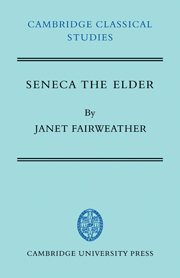Book contents
- Frontmatter
- Contents
- Preface
- Abbreviations
- PART I THE PLACE OF SENECA THE ELDER IN LITERARY HISTORY
- PART II SENECA THE ELDER ON THE HISTORY OF ELOQUENCE
- PART III FIVE ASPECTS OF DECLAMATION: THE ELDER SENECA'S EVIDENCE
- PART IV THE PLACE OF EARLY IMPERIAL DECLAMATION IN LITERARY HISTORY: THE ELDER SENECA'S EVIDENCE
- 1 Asianism, Atticism, and the styles of the declaimers
- 2 Declamation and literary modernism in the early Empire
- Appendix: Clausula usage of Seneca, Latro and Fuscus
- Notes
- Bibliography
- Indexes
1 - Asianism, Atticism, and the styles of the declaimers
Published online by Cambridge University Press: 10 March 2010
- Frontmatter
- Contents
- Preface
- Abbreviations
- PART I THE PLACE OF SENECA THE ELDER IN LITERARY HISTORY
- PART II SENECA THE ELDER ON THE HISTORY OF ELOQUENCE
- PART III FIVE ASPECTS OF DECLAMATION: THE ELDER SENECA'S EVIDENCE
- PART IV THE PLACE OF EARLY IMPERIAL DECLAMATION IN LITERARY HISTORY: THE ELDER SENECA'S EVIDENCE
- 1 Asianism, Atticism, and the styles of the declaimers
- 2 Declamation and literary modernism in the early Empire
- Appendix: Clausula usage of Seneca, Latro and Fuscus
- Notes
- Bibliography
- Indexes
Summary
Eduard Norden, who in his Antike Kunstprosa viewed the whole history of Hellenistic and Latin prose style as a centuries-long battle between the rival tendencies of Atticism and Asianism, was confident that what he called the new style (der neue Stil) characteristic of early Imperial declaimers, could in its entirety be regarded as a manifestation of Asianism. Various points emerge, however, from the elder Seneca's criticism of the declaimers which suggest that Norden's diagnosis was an over–simplification. First, it is evident that, however uniform in style declamatory sententiae as excerpted by the elder Seneca may seem to readers today, the sensitive ears of the anthologist himself detected many distinct genera dicendi in use among the declaimers of his time, not just one all-embracing type of modernity. Secondly, though the elder Seneca does use the term Asianus in his criticism, it is noteworthy that he does so very sparingly, applying this epithet only to four Greek declaimers and probably, though the text of the passage in question is doubtful, to one Latin declaimer, namely Fuscus, whose style, as we have seen, had certain characteristics which set it apart from that of Latro and the genus dicendi ardens et concitatum which was Seneca's ideal.
- Type
- Chapter
- Information
- Seneca the Elder , pp. 243 - 303Publisher: Cambridge University PressPrint publication year: 1981



